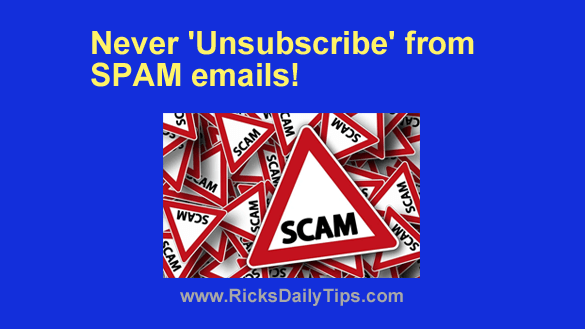 Rick’s Tech Tips Newsletter
Rick’s Tech Tips Newsletter
Like most everyone else, you probably receive SPAM and phishing emails all the time.
And despite the existence of the Can-Spam act, this scourge of the Internet seems to actually be getting worse instead of better.
If you ever happen to accidentally open one of these obnoxious messages you might be tempted to click the “Unsubscribe” link located near the bottom of the message to have your email address removed from their mailing list.
Whatever you do, don’t click that link! Read on to find out why…
Why you should avoid clicking “Unsubscribe” in SPAM messages
Clicking “Unsubscribe” in a fraudulent email will not result in your email address being removed from the scammer’s email list. What it WILL do is one, or both of the following:
1 – Verify for the scammer that your email address is in fact a valid and active address (which will have the unwanted side effect of making your email address even more valuable to the scammer in the future).
2 – Take you to a malicious website that will download malware onto your computer and/or trick you into falling for a scam offer of some sort.
I know how irritating it is to check your email and find dozens of SPAM messages filling up your inbox, but clicking “Unsubscribe” won’t help you avoid receiving that same email again. All it will do is end up attracting even more malicious junk in the future, and possibly worse.
How to properly handle your junk emails
The best way to handle SPAM and other forms of unwanted email is to simply mark them as “SPAM” or “Junk” (depending on which word your email provider uses) and then delete them without even opening them.
Of course there will be times when you open one of these emails by accident, regardless of how careful you are to avoid them. When that happens, simply mark the message as SPAM or Junk and then delete it.
Whatever you do, DO NOT click on the “Unsubscribe” link (or ANY link in the email for that matter).
What to do if you accidentally click a link in a SPAM message
If you accidentally click ANY link in a SPAM message you should first deal with the email as explained above, then thoroughly scan your computer for malware by following the steps listed in this post.
And finally, one HUGE, and very important caveat…
Everything I said above only applies to SPAM emails, primarily emails you never signed up for or joined an email list to receive.
If you actually did sign up for a mailing list please don’t mark it as SPAM or Junk if you decide you don’t want to receive it any more. Use the Unsubscribe link in one of the emails instead. That’s what it’s there for.
We all sign up for things we believe we’ll like, only to find out that it really isn’t our cup of tea. It’s fine to Unsubscribe from those types of things, and that’s what the folks that send out legitimate emails want us to do.
The folks who run legitimate newsletters and other mailings that you legitimately signed up for are actually eager for you to unsubscribe if you ever change your mind about receiving their emails.
Why? Because unsubscribing does two very important things:
1 – It prevents them from continuing to send emails to people who aren’t interested in receiving them (and therefore never open them).
Unopened emails lower a newsletter’s “Open Rate”, which negatively affects the ISP’s quality scores for that newsletter’s email address.
2 – Marking an email that you signed up for as SPAM or Junk effectively does the same thing as number 1 – it negatively affects the newsletter’s ability to make it into the inboxes of the people who really want to receive it.
Here’s a general rule to follow:
If you receive a marketing email that you never signed up to receive you should mark it as SPAM or JUNK, because that’s truly what it is.
You shouldn’t click the Unsubscribe link if you never subscribed to that list in the first place.
However, if you receive emails that you actually signed up for (i.e. subscribed to) but later decide you want to have your email address removed from their list, use the Unsubscribe link instead of marking it as SPAM.
That will ensure that you never receive another email from that sender without negatively affecting the deliverability of their newsletter to the other people who signed up for their emails and want to continue receiving them.